| 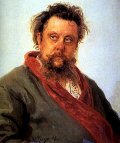 Modest Mussorgsky Modest Mussorgsky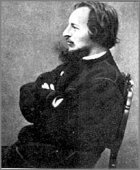 Victor Hartmann Victor Hartmann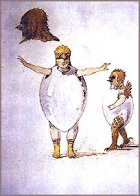 Bydlo - Ox Cart The heavy leaden walk of the cattle is heard pulling the cart slowly through the mud. Again, Hartmann's sketch is lost.Ballet of the Unhatched Chicks Hartmanns sketch is for the costume design for an opera called Trilbi by Julius Gerber. The music describes a frenetic, chaotic dance of children dressed as unhatched chicks. Hartmann's original design is at right.Samuel Goldenberg & Schmuyle Bydlo - Ox Cart The heavy leaden walk of the cattle is heard pulling the cart slowly through the mud. Again, Hartmann's sketch is lost.Ballet of the Unhatched Chicks Hartmanns sketch is for the costume design for an opera called Trilbi by Julius Gerber. The music describes a frenetic, chaotic dance of children dressed as unhatched chicks. Hartmann's original design is at right.Samuel Goldenberg & Schmuyle Samuel Goldenburg and Schmuyle were originally the subjects of two separate paintings by Hartman of two Jews from Sandomir in Poland. Samuel Goldberg is richly dressed, and Schmuyle is in rags (only this painting survives, at right). Mussorgsky combines the two paintings into one piece of music where he depicts a conversation between the two. The rich Jew is represented by a heavy pompous theme, the poor man by a high-pitched bleating theme. As time goes on, the rich man's voice drowns out the other's, as the themes merge.Limoges marche - The Market at Limoges Another Promenade takes us to a marketplace at Limoges, the music depicting the hustle and bustle of women and haggling vendors. Samuel Goldenburg and Schmuyle were originally the subjects of two separate paintings by Hartman of two Jews from Sandomir in Poland. Samuel Goldberg is richly dressed, and Schmuyle is in rags (only this painting survives, at right). Mussorgsky combines the two paintings into one piece of music where he depicts a conversation between the two. The rich Jew is represented by a heavy pompous theme, the poor man by a high-pitched bleating theme. As time goes on, the rich man's voice drowns out the other's, as the themes merge.Limoges marche - The Market at Limoges Another Promenade takes us to a marketplace at Limoges, the music depicting the hustle and bustle of women and haggling vendors.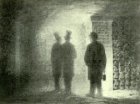 Catacombae Sepulcrum romanum - Roman Burial Catacombs This eerie picture is a self-portrait of Hartmann touring the ancient Roman burial catacombs under Paris, based on Victor Hugo's description in Les Miserable. The source of the glow was candles and oil within the skulls.Con mortuis in lingua mortua - With the Dead in the Language of Death The catacombs leads to a section not directly inspired by a Hartmann painting. It is Mussorgsky's reflections on the death of his friend. Catacombae Sepulcrum romanum - Roman Burial Catacombs This eerie picture is a self-portrait of Hartmann touring the ancient Roman burial catacombs under Paris, based on Victor Hugo's description in Les Miserable. The source of the glow was candles and oil within the skulls.Con mortuis in lingua mortua - With the Dead in the Language of Death The catacombs leads to a section not directly inspired by a Hartmann painting. It is Mussorgsky's reflections on the death of his friend.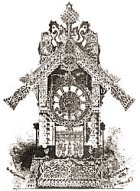 The Hut on Fowl's Legs (Baba-Yaga) Hartmann's design was for an ornate clock inspired by the ancient folktale of the Baba Yaga, the witch who lives in a house on chicken legs. Mussorgsky's music depicts the witch flying through the air in her mortar in which she grinds human bones. She flies into a forest, her hut following her on the ground. The music is subdued and menacing. Then all of a sudden she re-appears, hurtling through the sky, straight into the final piece of music.The Great Gate of Kiev The Hut on Fowl's Legs (Baba-Yaga) Hartmann's design was for an ornate clock inspired by the ancient folktale of the Baba Yaga, the witch who lives in a house on chicken legs. Mussorgsky's music depicts the witch flying through the air in her mortar in which she grinds human bones. She flies into a forest, her hut following her on the ground. The music is subdued and menacing. Then all of a sudden she re-appears, hurtling through the sky, straight into the final piece of music.The Great Gate of Kiev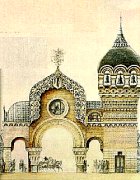 The Great Gate of Kiev was a project that never saw the light of day. It was Hartmann's entry for a competition to design a commemorative building to celebrate Tsar Alexander II's miraculous escape from an assasination attempt. It is the Promenade theme again but this time in a purposeful 4/4 time. It describes the grandness of the gate, with its Slavonic helmet-inspired arch and a grand bell tower by its side, from which sounds a victorious tolling of bells. Mussorgsky's original piano version of Pictures was not even published until 5 years after his death, and remained almost unknown until Ravel's masterful orchestration of it in 1922. From then on it has become an orchestral favourite. So much so that the original piano version is rarely heard. Yet this really shows the true Mussorgsky, still richly layered music, but filled with raw energy. The piano and pianist must be capable of alternating between sweet singing, biting humour and pounding threat. Evgeny Kissin is one of the world's great pianists, mature beyond his years (he was born in 1971). His concerts are sell-outs the world over, his stage presence electrifying, and his choice of program both intelligent and challenging. He brings to the Pictures exactly the vigour that is required. This recording easily betters the classic Horowitz recording of the 1960's in my book. And includes some well-known Bach works (for keyboard and organ) and a surprise by Glinka. If his recording of Pictures at an Exhibition is anything to go on, this young man has far to go. The Great Gate of Kiev was a project that never saw the light of day. It was Hartmann's entry for a competition to design a commemorative building to celebrate Tsar Alexander II's miraculous escape from an assasination attempt. It is the Promenade theme again but this time in a purposeful 4/4 time. It describes the grandness of the gate, with its Slavonic helmet-inspired arch and a grand bell tower by its side, from which sounds a victorious tolling of bells. Mussorgsky's original piano version of Pictures was not even published until 5 years after his death, and remained almost unknown until Ravel's masterful orchestration of it in 1922. From then on it has become an orchestral favourite. So much so that the original piano version is rarely heard. Yet this really shows the true Mussorgsky, still richly layered music, but filled with raw energy. The piano and pianist must be capable of alternating between sweet singing, biting humour and pounding threat. Evgeny Kissin is one of the world's great pianists, mature beyond his years (he was born in 1971). His concerts are sell-outs the world over, his stage presence electrifying, and his choice of program both intelligent and challenging. He brings to the Pictures exactly the vigour that is required. This recording easily betters the classic Horowitz recording of the 1960's in my book. And includes some well-known Bach works (for keyboard and organ) and a surprise by Glinka. If his recording of Pictures at an Exhibition is anything to go on, this young man has far to go. |